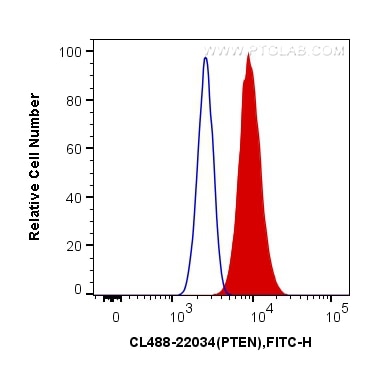- Phare
- Validé par KD/KO
Anticorps Polyclonal de lapin anti-PTEN
PTEN Polyclonal Antibody for FC (Intra)
Hôte / Isotype
Lapin / IgG
Réactivité testée
Humain, souris
Applications
FC (Intra)
Conjugaison
CoraLite® Plus 488 Fluorescent Dye
N° de cat : CL488-22034
Synonymes
Galerie de données de validation
Applications testées
| Résultats positifs en cytométrie | cellules HeLa |
Dilution recommandée
| Application | Dilution |
|---|---|
| Flow Cytometry (FC) | FC : 0.40 ug per 10^6 cells in a 100 µl suspension |
| It is recommended that this reagent should be titrated in each testing system to obtain optimal results. | |
| Sample-dependent, check data in validation data gallery | |
Informations sur le produit
CL488-22034 cible PTEN dans les applications de FC (Intra) et montre une réactivité avec des échantillons Humain, souris
| Réactivité | Humain, souris |
| Hôte / Isotype | Lapin / IgG |
| Clonalité | Polyclonal |
| Type | Anticorps |
| Immunogène | PTEN Protéine recombinante Ag17274 |
| Nom complet | phosphatase and tensin homolog |
| Masse moléculaire calculée | 47 kDa |
| Poids moléculaire observé | 55 kDa, 68 kDa |
| Numéro d’acquisition GenBank | BC005821 |
| Symbole du gène | PTEN |
| Identification du gène (NCBI) | 5728 |
| Conjugaison | CoraLite® Plus 488 Fluorescent Dye |
| Excitation/Emission maxima wavelengths | 493 nm / 522 nm |
| Forme | Liquide |
| Méthode de purification | Purification par affinité contre l'antigène |
| Tampon de stockage | PBS avec glycérol à 50 %, Proclin300 à 0,05 % et BSA à 0,5 %, pH 7,3. |
| Conditions de stockage | Stocker à -20 °C. Éviter toute exposition à la lumière. L'aliquotage n'est pas nécessaire pour le stockage à -20oC Les 20ul contiennent 0,1% de BSA. |
Informations générales
Phosphatase and tensin homolog (PTEN) is an enzyme key in cell cycle regulation and in tumor suppression.
What is the molecular weight of PTEN?
PTEN is composed of 403 amino acid residues with an N-terminal domain with phosphatase activity and a
C-terminal C2 domain that binds phospholipid membranes (PMID:14749127). This antibody can recognize
two isoforms with MWs of 55kDa and 68 kDa.
What is the function of PTEN?
Widely expressed throughout the body, PTEN is found in the cytoplasm and inhibits cell cycle progression
through phosphatase activity. It regulates intracellular levels of phosphatidylinositol-3,4,5-trisphosphate (PIP3)
by catalyzing the dephosphorylation of the inositol ring. This function counteracts the growth-stimulating
activity of the PI3K/AKT signaling pathway and thereby suppresses proliferation. Therefore, in homeostasis,
PTEN promotes chromosome stability and DNA repair (PMID: 24387334).Expression and function can be
regulated by posttranslational modifications, including acetylation for decreased catalytic activity and
ubiquitination for protein degradation, nuclear localization, and inhibition of phosphatase activity
(PMID: 24656806).
What is the role of PTEN in cancer?
PTEN was first identified as a tumor suppressor when mutations or deletions were identified by two separate
groups in a number of different cancer types including gliomas, breast, prostate, and kidney cancer
(PMID: 9090379; PMID: 9072974). Non-inherited, or somatic, mutations in PTEN that lead to a loss of function
in the protein have been shown to drive malignancy in tumors. PTEN hamartoma tumor syndrome (PHTS) is a
group of inherited disorders that occur as a result of autosomal dominant mutations in the PTEN gene. These
disorders include Cowden syndrome, Bannayan-Riley-Ruvalcaba syndrome, and Proteus syndrome. Because of
the constitutive expression of PTEN, the symptoms are varied but often include neurodevelopmental issues and
an increased risk of developing tumors, both benign and malignant (PMID: 26564076).
Protocole
| Product Specific Protocols | |
|---|---|
| FC protocol for CL Plus 488 PTEN antibody CL488-22034 | Download protocol |
| Standard Protocols | |
|---|---|
| Click here to view our Standard Protocols |



